Performance of Four Full-Scale Artificially Aerated Horizontal Flow Constructed Wetlands for Domestic Wastewater Treatment
Abstract
:1. Introduction
2. Materials and Methods
2.1. Site Details
2.2. Sampling and Analysis
2.3. Hydraulic Characterisation
2.4. Robustness and Resilience Analysis
3. Results and Discussion
3.1. Ammonium Removal
3.2. Process Robustness
3.3. Solids and Organics Removal
3.4. Hydraulic Characterisation
4. Conclusions
Supplementary Materials
Acknowledgments
Author Contributions
Conflicts of Interest
References
- Ishikawa, S.; Suzuki, T.; Nikata, T.; Kakii, K.; Shirakashi, T. Tertiary nitrification in a new dual-medium aerated filter. Water Sci. Technol. 2003, 47, 219–237. [Google Scholar] [PubMed]
- Butterworth, E.; Dotro, G.; Jones, M.; Richards, A.; Onunkwo, P.; Narroway, Y.; Jefferson, B. Effect of artificial aeration on tertiary nitrification in a full-scale subsurface horizontal flow constructed wetland. Ecol. Eng. 2013, 54, 236–244. [Google Scholar] [CrossRef]
- García, J.; Aguirre, P.; Barragán, J.; Mujeriego, R.; Matamoros, V.; Bayona, J.M. Effect of key design parameters on the efficiency of horizontal subsurface flow constructed wetlands. Ecol. Eng. 2005, 25, 405–418. [Google Scholar] [CrossRef]
- Gross, A.; Sklarz, M.Y.; Yakirevich, A.; Soares, M.I.M. Small scale recirculating vertical flow constructed wetland (RVFCW) for the treatment and reuse of wastewater. Water Sci. Technol. 2008, 58, 487–494. [Google Scholar] [CrossRef] [PubMed]
- Brix, H.; Arias, C.A. The use of vertical flow constructed wetlands for on-site treatment of domestic wastewater: New Danish guidelines. Constr. Wetl. Wastewater Treat. 2005, 25, 491–500. [Google Scholar] [CrossRef]
- Wu, S.; Zhang, D.; Austin, D.; Dong, R.; Pang, C. Evaluation of a lab-scale tidal flow constructed wetland performance: Oxygen transfer capacity, organic matter and ammonium removal. Ecol. Eng. 2011, 37, 1789–1795. [Google Scholar] [CrossRef]
- Foladori, P.; Ruaben, J.; Ortigara, A. Recirculation or artificial aeration in vertical flow constructed wetlands: A comparative study for treating high load wastewater. Bioresour. Technol. 2013, 149, 398–405. [Google Scholar] [CrossRef] [PubMed]
- Nivala, J.; Headley, T.; Wallace, S.; Bernhard, K.; Brix, H.; van Afferden, M.; Müller, R.A. Comparative analysis of constructed wetlands: The design and construction of the ecotechnology research facility in Langenreichenbach, Germany. Ecol. Eng. 2013, 61, 527–543. [Google Scholar] [CrossRef]
- Maltais-Landry, G.; Maranger, R.; Brisson, J. Effect of artificial aeration and macrophyte species on nitrogen cycling and gas flux in constructed wetlands. Ecol. Eng. 2009, 35, 221–229. [Google Scholar] [CrossRef]
- Fan, J.; Wang, W.; Zhang, B.; Guo, Y.; Ngo, H.H.; Guo, W.; Zhang, J.; Wu, H. Nitrogen removal in intermittently aerated vertical flow constructed wetlands: Impact of influent COD/N ratios. Bioresour. Technol. 2013, 143, 461–466. [Google Scholar] [CrossRef] [PubMed]
- Matthys, A.; Parkin, G.; Wallace, S. A comparison of constructed wetlands used to treat domesitc wastes: Conventional, drawdown, and aerated systems. In Proceedings of the 7th International Conference on Wetland Systems for Water Pollution Control, Lake Buena Vista, FL, USA, 11–16 November 2000; International Water Association, Ed.; International Water Association: Colchester, UK, 2000. [Google Scholar]
- Dong, H.; Qiang, Z.; Li, T.; Jin, H.; Chen, W. Effect of artificial aeration on the performance of vertical-flow constructed wetland treating heavily polluted river water. J. Environ. Sci. 2012, 24, 596–601. [Google Scholar] [CrossRef]
- Nivala, J.; Hoos, M.B.; Cross, C.; Wallace, S.; Parkin, G. Treatment of landfill leachate using an aerated, horizontal subsurface-flow constructed wetland. Sci. Total Environ. 2007, 380, 19–27. [Google Scholar] [CrossRef] [PubMed]
- Wallace, S.; Kadlec, R. BTEX degradation in a cold-climate wetland system. Water Sci. Technol. 2005, 51, 165–171. [Google Scholar] [PubMed]
- Knowles, P.; Dotro, G.; Nivala, J.; García, J. Clogging in subsurface-flow treatment wetlands: Occurrence and contributing factors. Ecol. Eng. 2011, 37, 99–112. [Google Scholar] [CrossRef]
- American Public Health Association (APHA). Standard Methods for the Examination of Water and Wastewater, 21st ed.; APHA: Washington, DC, USA, 2005. [Google Scholar]
- Pedescoll, A.; Uggetti, E.; Llorens, E.; Granés, F.; García, D.; García, J. Practical method based on saturated hydraulic conductivity used to assess clogging in subsurface flow constructed wetlands. Ecol. Eng. 2009, 35, 1216–1224. [Google Scholar] [CrossRef]
- Pedescoll, A.; Samsó, R.; Romero, E.; Puigagut, J.; García, J. Reliability, repeatability and accuracy of the falling head method for hydraulic conductivity measurements under laboratory conditions. Ecol. Eng. 2011, 37, 754–757. [Google Scholar] [CrossRef]
- Hartshorn, A.J.; Prpich, G.; Upton, A.; Macadam, J.; Jefferson, B.; Jarvis, P. Assessing filter robustness at drinking water treatment plants. Water Environ. J. 2015, 29, 16–26. [Google Scholar] [CrossRef]
- Llorens, E.; Matamoros, V.; Domingo, V.; Bayona, J.M.; García, J. Water quality improvement in a full-scale tertiary constructed wetland: Effects on conventional and specific organic contaminants. Sci. Total Environ. 2009, 407, 2517–2524. [Google Scholar] [CrossRef] [PubMed]
- O’Luanaigh, N.D.; Goodhue, R.; Gill, L.W. Nutrient removal from on-site domestic wastewater in horizontal subsurface flow reed beds in Ireland. Ecol. Eng. 2010, 36, 1266–1276. [Google Scholar] [CrossRef]
- Albuquerque, A.; Oliveira, J.; Semitela, S.; Amaral, L. Influence of bed media characteristics on ammonia and nitrate removal in shallow horizontal subsurface flow constructed wetlands. Bioresour. Technol. 2009, 100, 6269–6277. [Google Scholar] [CrossRef]
- Yousefi, Z.; Mohseni-Bandpei, A. Nitrogen and phosphorus removal from wastewater by subsurface wetlands planted with Iris pseudacorus. Ecol. Eng. 2010, 36, 777–782. [Google Scholar] [CrossRef]
- Cottingham, P.; Davies, T.; Hart, B. Aeration to promote nitrification in constructed wetlands. Environ. Technol. 1999, 20, 69–75. [Google Scholar] [CrossRef]
- Vymazal, J. Long-term performance of constructed wetlands with horizontal sub-surface flow: Ten case studies from the Czech Republic. Ecol. Eng. 2011, 37, 54–63. [Google Scholar] [CrossRef]
- Boller, M.; Gujer, W. Nitrification in tertiary trickling filters followed by deep-bed filters. Water Res. 1986, 20, 1363–1373. [Google Scholar] [CrossRef]
- Pickering, R.L. How Hard is the Biomass Working? Ph.D. Thesis, University of Newcastle Upon Tyne, Newcastle Upon Tyne, UK, 2008. [Google Scholar]
- Pearce, P. Sustainable processes to meet low ammonia consents—The small works challenge. In Proceedings of the 2nd Conference on Low Energy Wastewater Treatment Systems, Solihull, UK, 24 September 2013.
- Kappel, C. Simplified Evaluation of the Operational Oxygen Transfer Efficiency of a Novel Dispersed Integrated Fixed Film Activated Sludge Process. Ph.D. Thesis, Cranfield University, Cranfield, UK, 2009. [Google Scholar]
- Chazarenc, F.; Gagnon, V.; Comeau, Y.; Brisson, J. Effect of plant and artificial aeration on solids accumulation and biological activities in constructed wetlands. Ecol. Eng. 2009, 35, 1005–1010. [Google Scholar] [CrossRef]
- Butterworth, E.; Richards, A.; Jones, M.; Dotro, G.; Jefferson, B. Assessing the potential for tertiary nitrification in sub-surface flow constructed wetlands. Environ. Technol. Rev. 2016. [Google Scholar] [CrossRef]
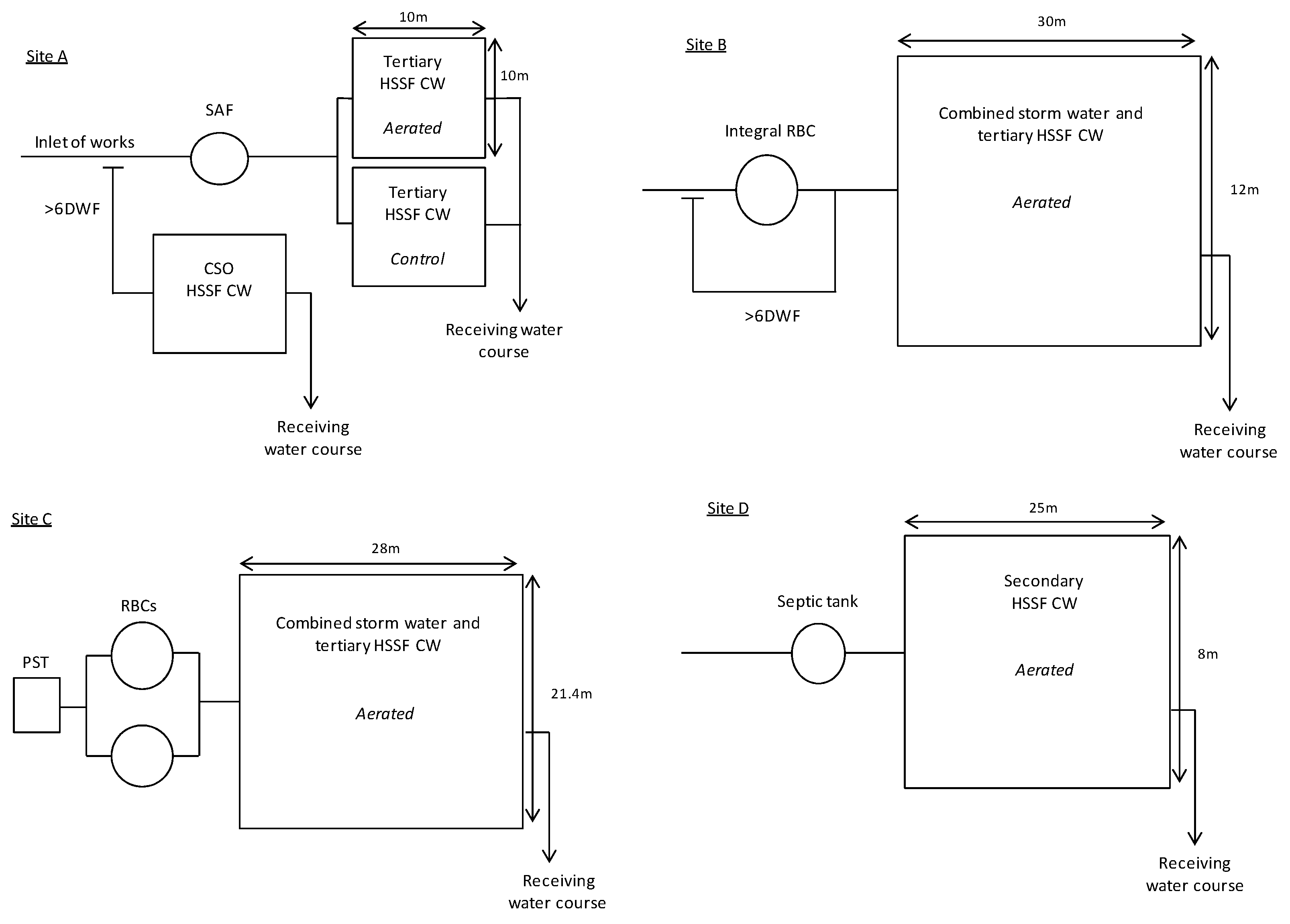
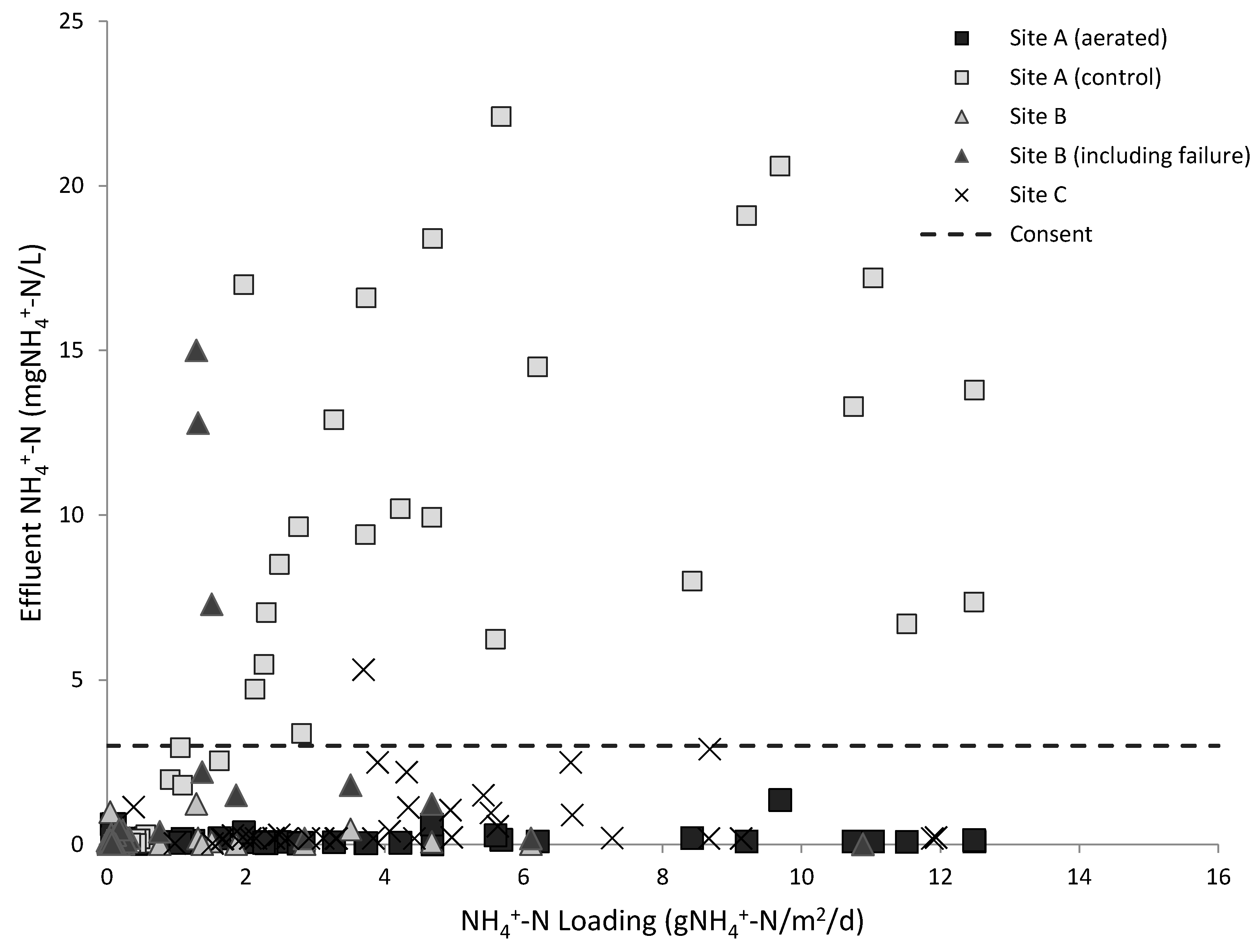
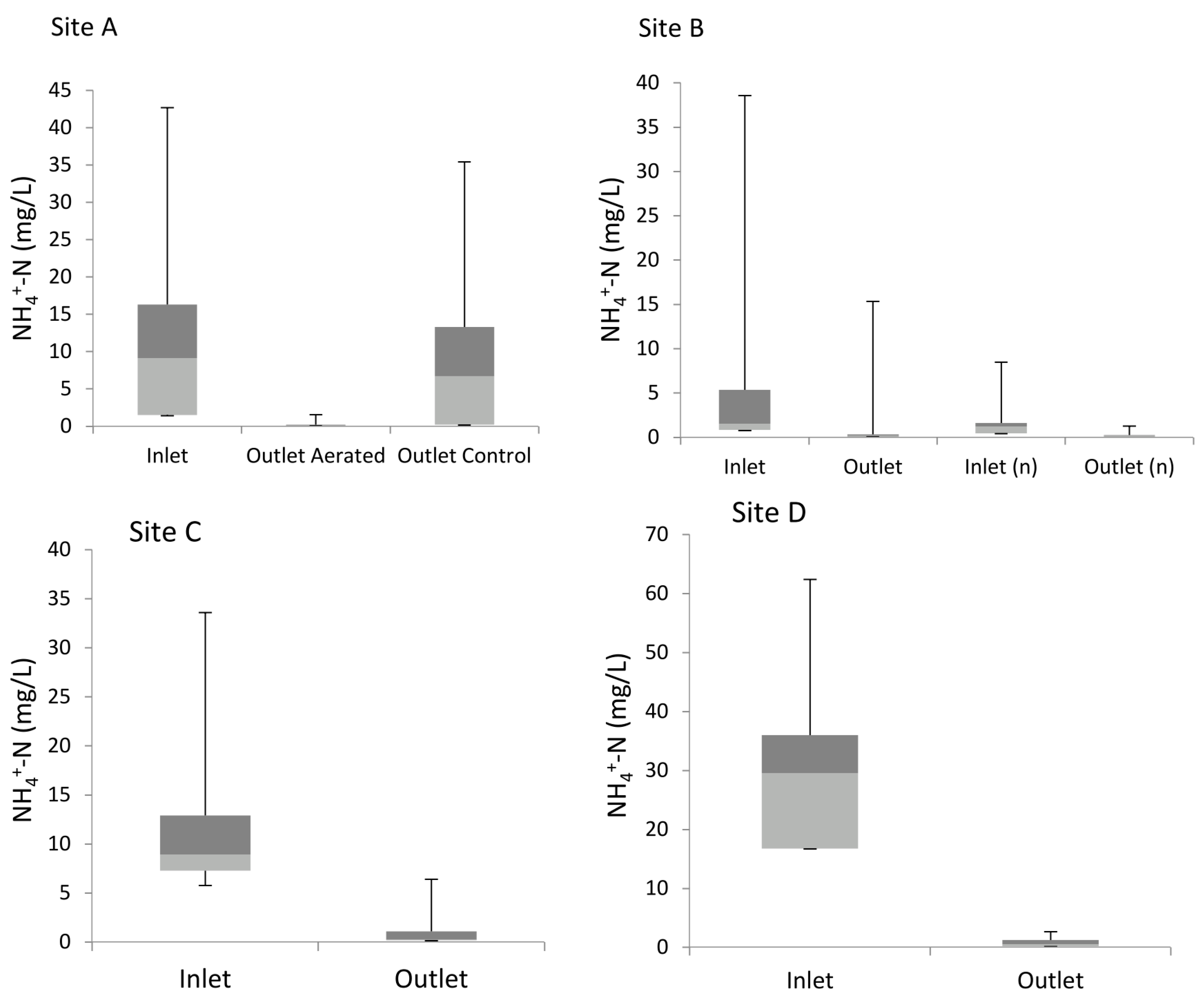

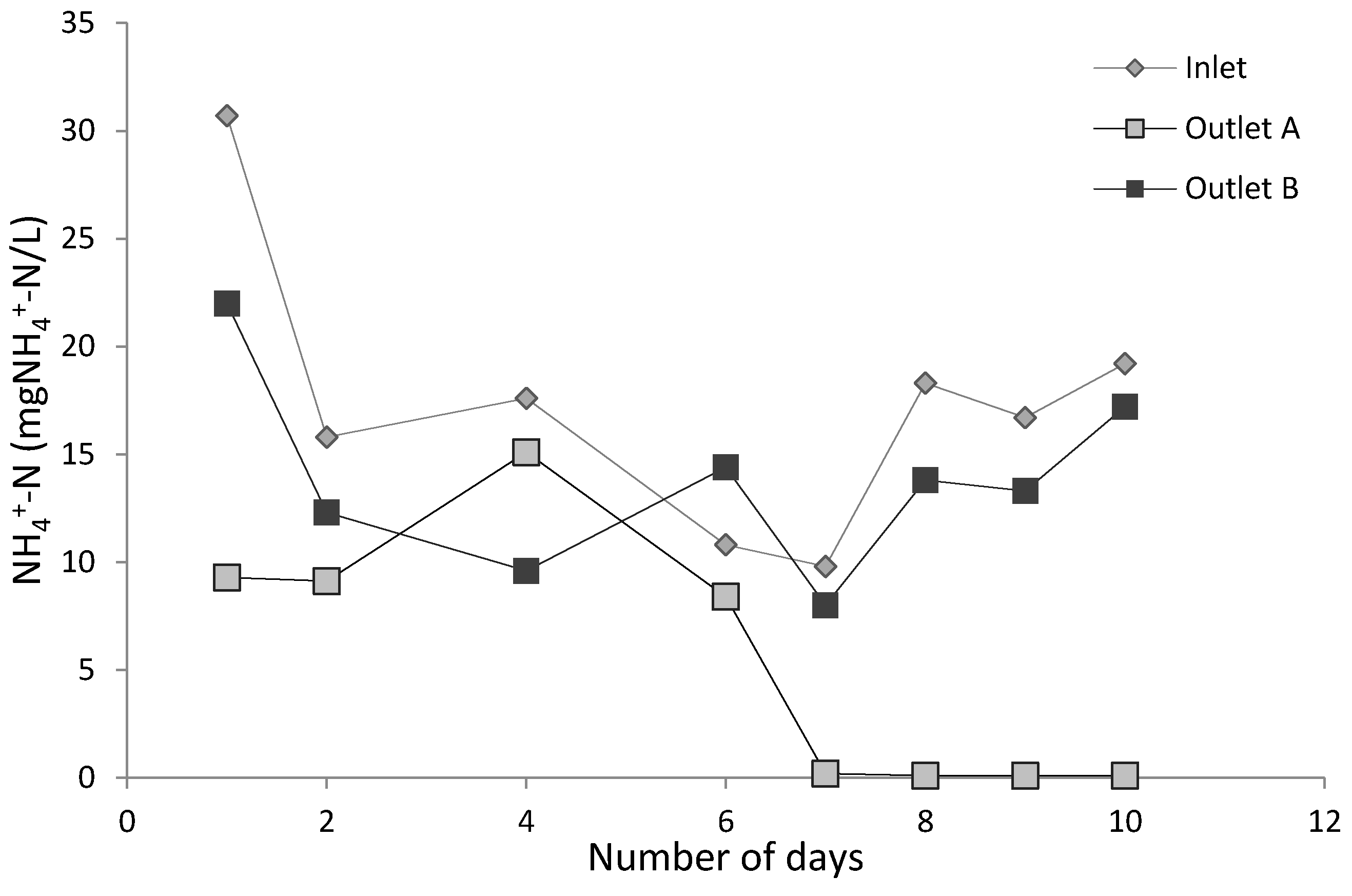
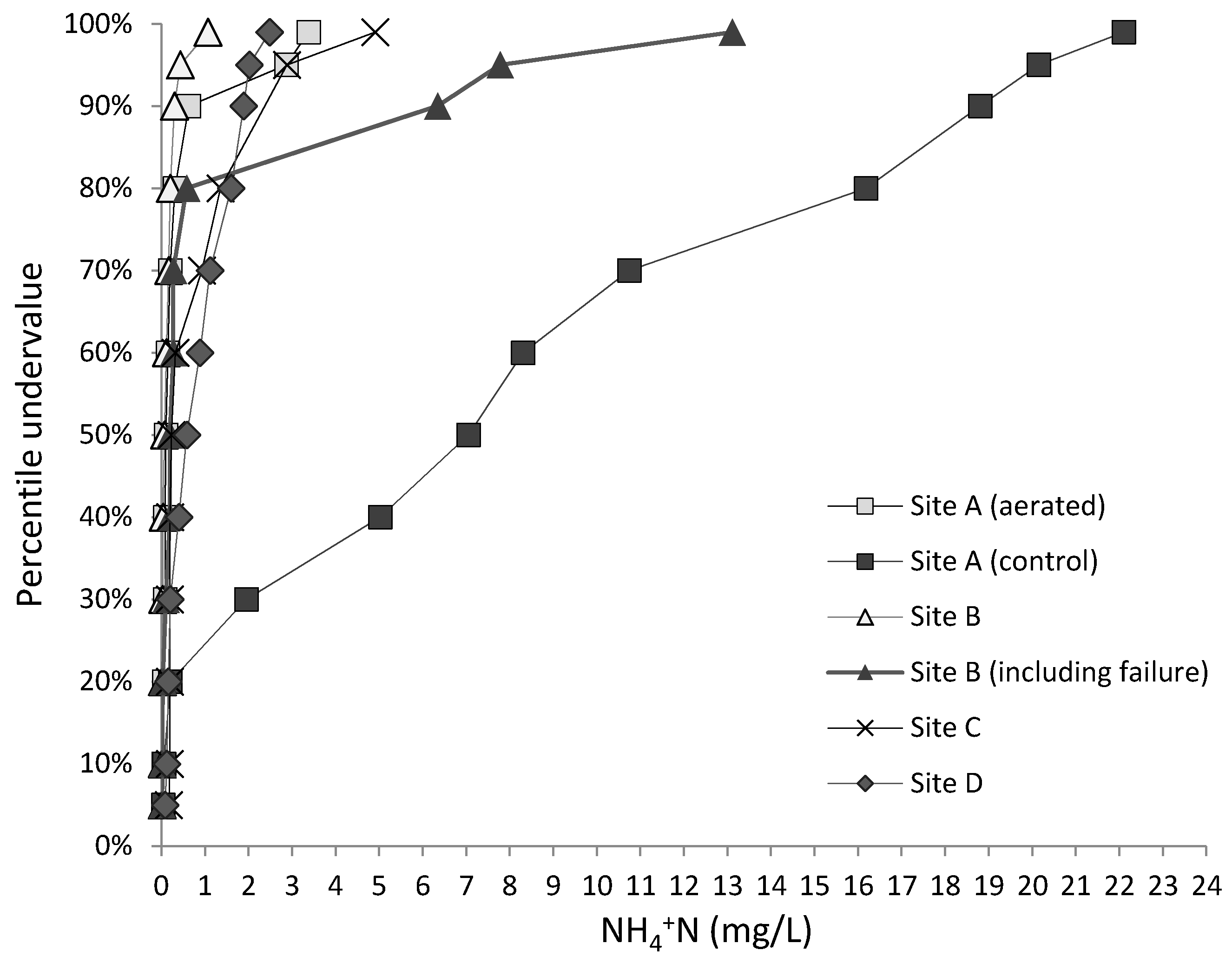



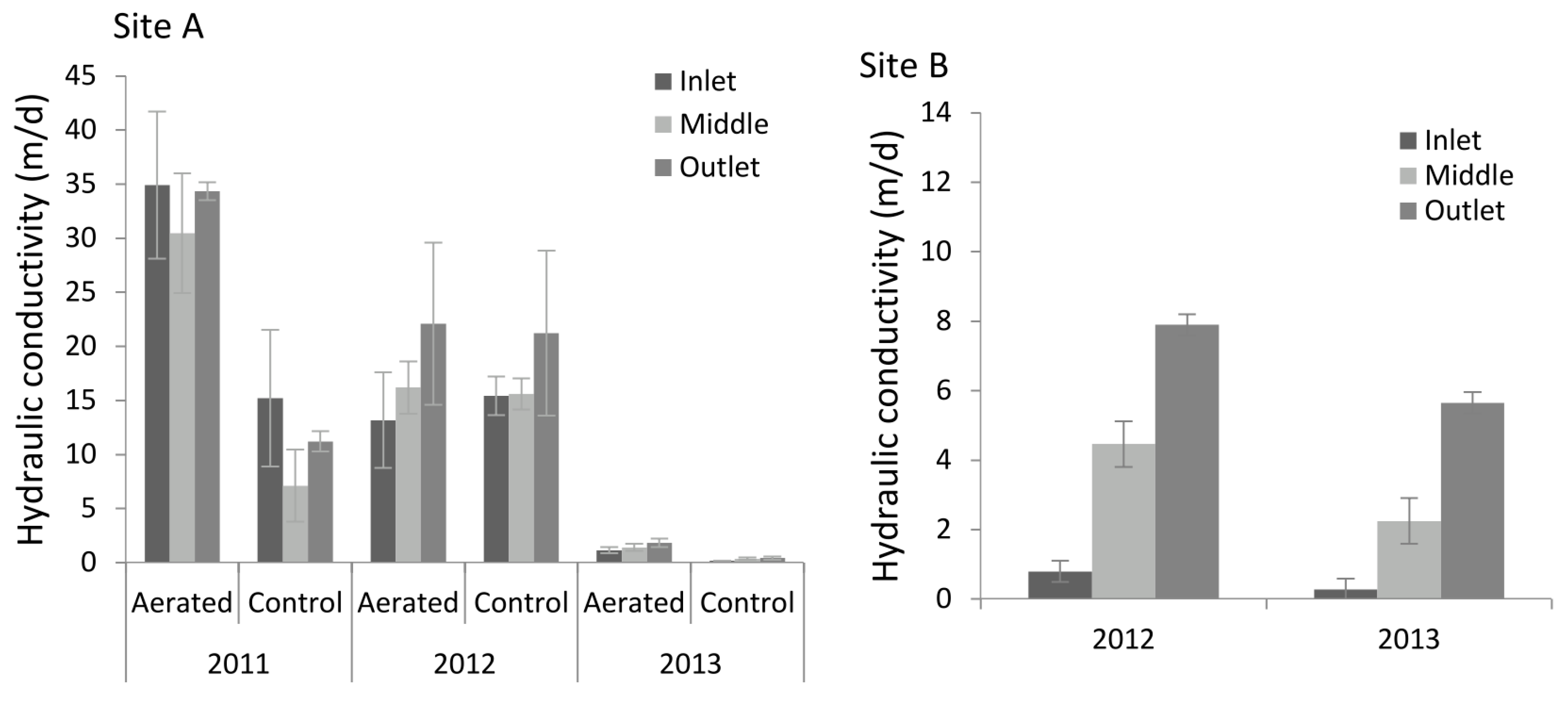
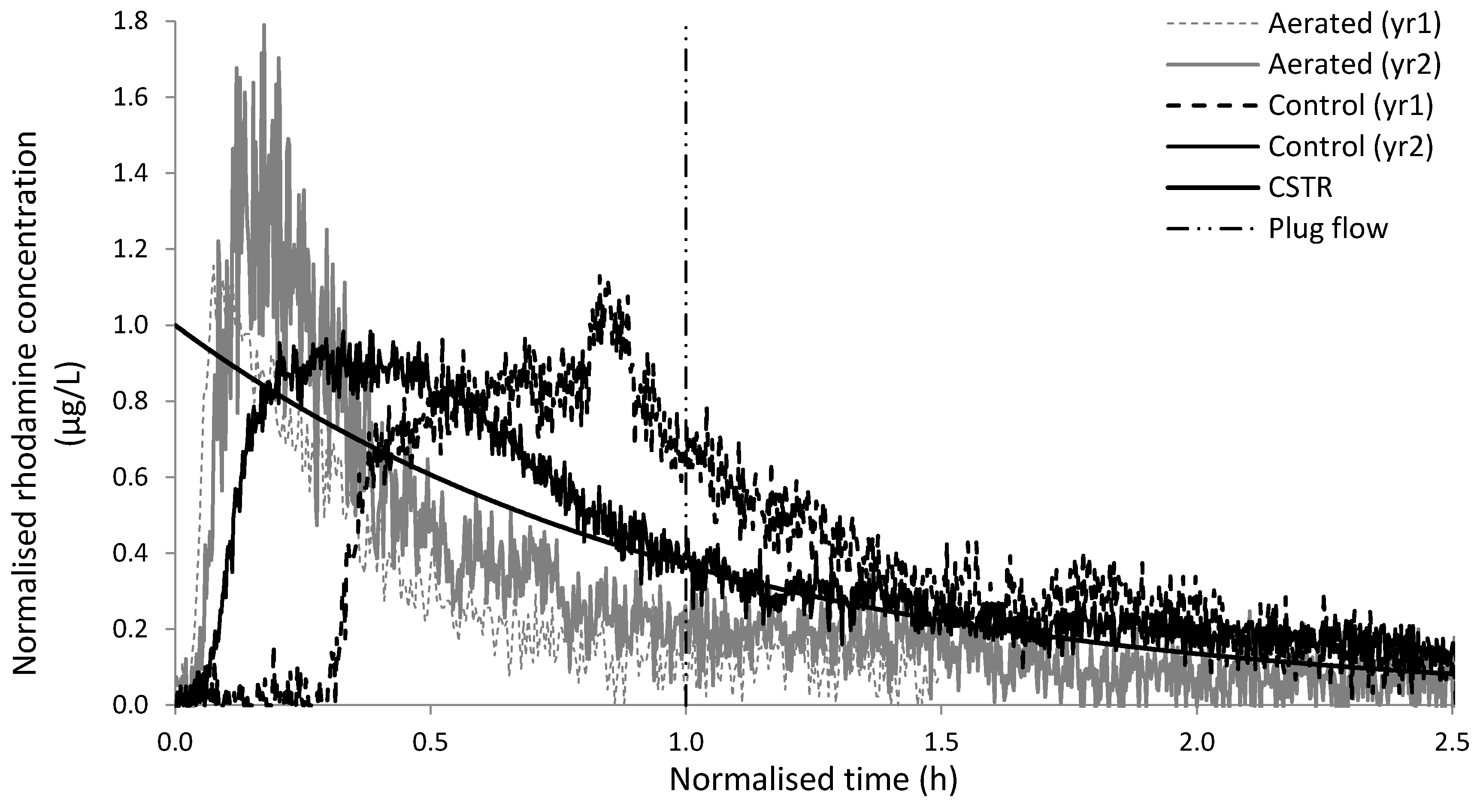
| Site | Treatment Stage | PE | Process Area m2 | Aeration Power W/m3 | Hydraulic Retention Time (HRT) d | Average Flow m3/d | Current Consent | Future Consent | ||||
|---|---|---|---|---|---|---|---|---|---|---|---|---|
| BOD | TSS | NH4-N | BOD | TSS | NH4-N | |||||||
| A | Tertiary | 393 | 200 | 26.7 | 0.7 | 65 | 30 | 45 | n/a | 21 | 45 | 4 |
| B | Combined a | 396 | 360 | 6.7 | 1.2 | 76 | 25 | 45 | 10 | 14 | 45 | 3 |
| C | Combined a | 600 | 600 | 4.4 | 0.8 | 180 | 30 | 50 | n/a | 30 | 50 | 12 |
| D | Secondary | 58 | 200 | 13.3 | 3.1 | 16 | D | D | D | D | D | D |
| Season | Site | Loading (gNH4+-N/m2/d) | Outlet Concentration (mgNH4+-N/L) | |||||
|---|---|---|---|---|---|---|---|---|
| Median | Min | Max | Median | Min | Max | n | ||
| Summer | Site A (aerated) | 2.0 | 0.3 | 11.5 | 0.1 | 0.02 | 1.4 | 19 |
| Site A (control) | 2.0 | 0.3 | 11.5 | 6.5 | 0.03 | 20.6 | 19 | |
| Site B | 0.08 | 0.02 | 1.9 | 0.1 | 0.01 | 1.5 | 20 | |
| Site C | 0.04 | 0.01 | 0.07 | 0.2 | 0.04 | 0.3 | 5 | |
| Site D | n/a | n/a | n/a | 0.5 | 0.1 | 2.6 | 11 | |
| Winter | Site A (aerated) | 2.8 | 0.07 | 12.5 | 0.1 | 0.02 | 0.6 | 23 |
| Site A (control) | 2.8 | 0.07 | 12.5 | 8.4 | 0.1 | 22.1 | 23 | |
| Site B | 0.2 | 0.02 | 10.9 | 0.2 | 0.02 | 15.0 | 22 | |
| Site C | 4.3 | 0.4 | 11.9 | 0.9 | 0.2 | 5.3 | 29 | |
| Site D | n/a | n/a | n/a | 1.2 | 0.1 | 13.3 | 20 | |
| Wetland Bed | Q (m3/h) | Recovery (%) | τn (h) | τ (h) | τp/τn | D | MDI | ev (%) |
|---|---|---|---|---|---|---|---|---|
| Aerated year 1 | 1.8 | 77 | 14.2 | 6.2 | 0.01 | 0.37 | 14.9 | 6.7 |
| Aerated year 2 | 1.8 | 72 | 14.2 | 24.5 | 0.17 | 0.59 | 31.7 | 3.2 |
| Control year 1 | 1.1 | 35 | 34.2 | 28.1 | 0.56 | 0.15 | 4.5 | 22.3 |
| Control year 2 | 1.2 | 67 | 21.2 | 14.7 | 0.33 | 0.26 | 9.0 | 11.1 |
© 2016 by the authors; licensee MDPI, Basel, Switzerland. This article is an open access article distributed under the terms and conditions of the Creative Commons Attribution (CC-BY) license (http://creativecommons.org/licenses/by/4.0/).
Share and Cite
Butterworth, E.; Richards, A.; Jones, M.; Mansi, G.; Ranieri, E.; Dotro, G.; Jefferson, B. Performance of Four Full-Scale Artificially Aerated Horizontal Flow Constructed Wetlands for Domestic Wastewater Treatment. Water 2016, 8, 365. https://doi.org/10.3390/w8090365
Butterworth E, Richards A, Jones M, Mansi G, Ranieri E, Dotro G, Jefferson B. Performance of Four Full-Scale Artificially Aerated Horizontal Flow Constructed Wetlands for Domestic Wastewater Treatment. Water. 2016; 8(9):365. https://doi.org/10.3390/w8090365
Chicago/Turabian StyleButterworth, Eleanor, Andrew Richards, Mark Jones, Gabriella Mansi, Ezio Ranieri, Gabriela Dotro, and Bruce Jefferson. 2016. "Performance of Four Full-Scale Artificially Aerated Horizontal Flow Constructed Wetlands for Domestic Wastewater Treatment" Water 8, no. 9: 365. https://doi.org/10.3390/w8090365






